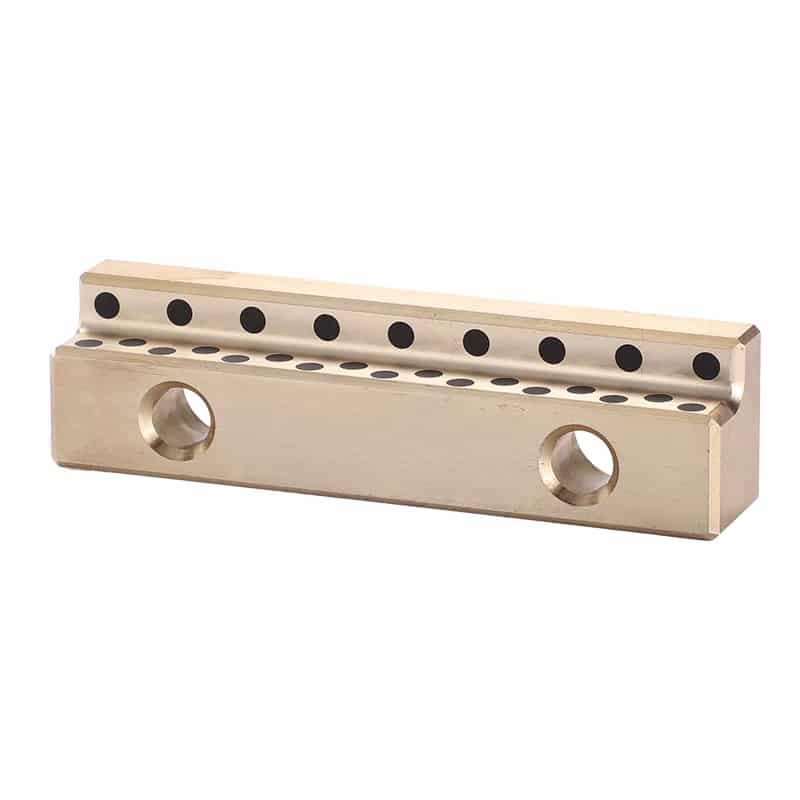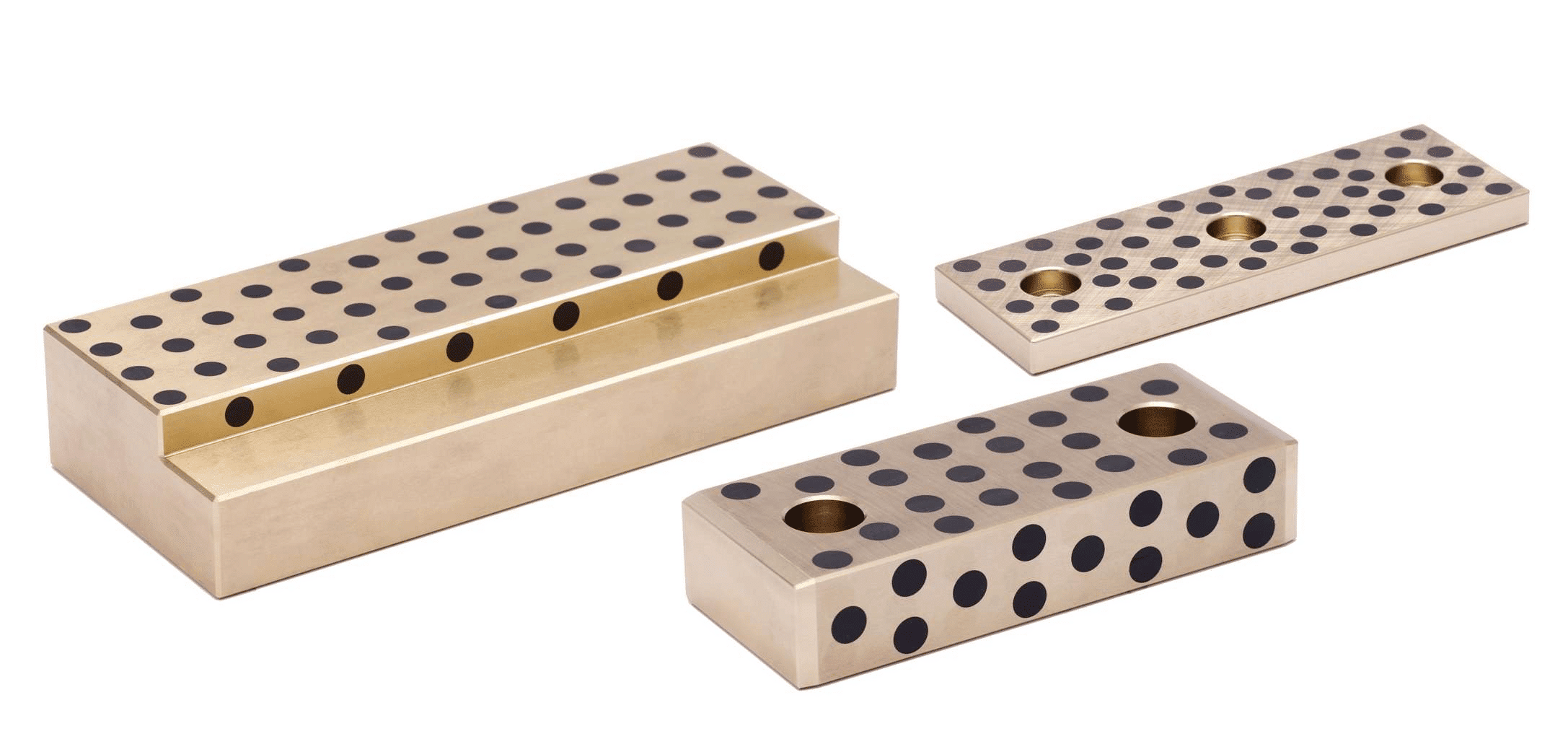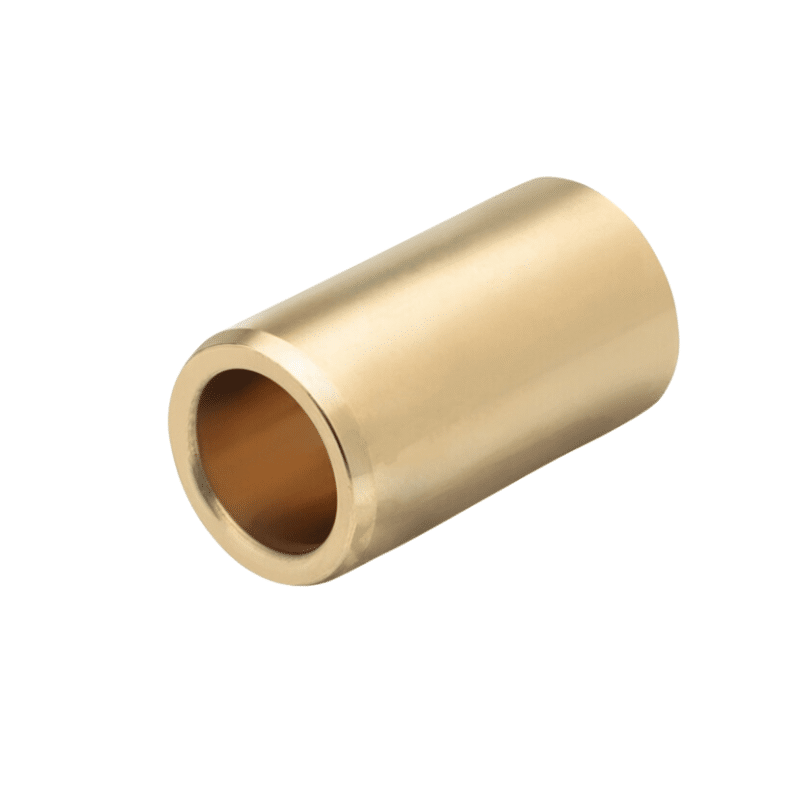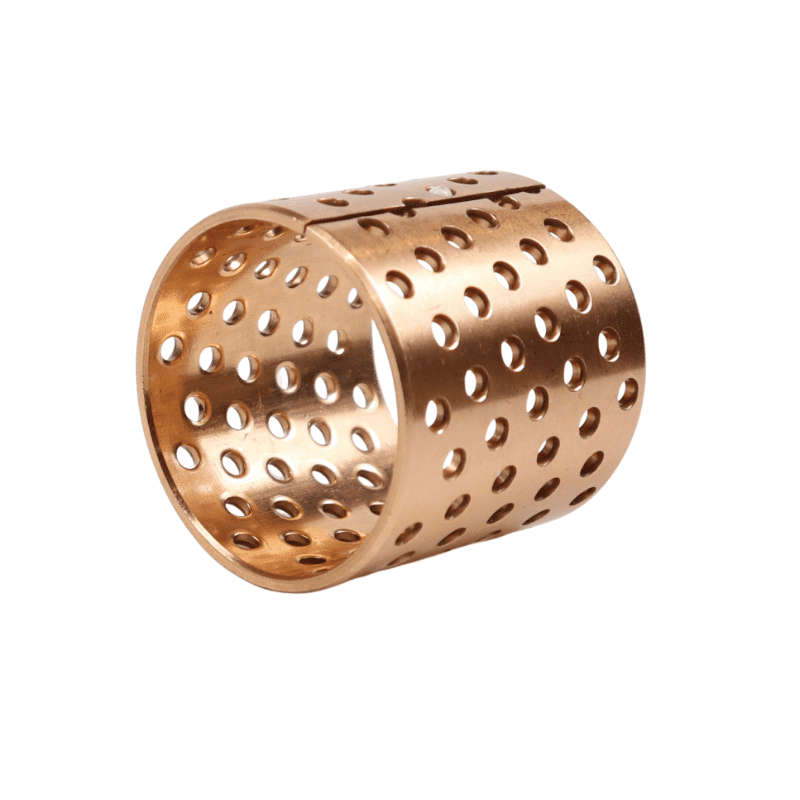Self lubricating slide plate
Self lubricating slide plate
Say goodbye to the hassle of frequent lubrication maintenance. Our self-lubricating technology ensures smooth operation and reduces wear and tear, extending the lifespan of your equipment. Experience uninterrupted productivity and cost savings as you bid farewell to the need for messy lubricants and time-consuming upkeep.
Manufacturing on Demand, alternative solutions
Self lubricating slide plate
Self-lubricating Slide Plate – Standard, Copper Alloy – Plugged Graphite – Select, configure order. Delivers punctually & offers fair prices.
The Ultimate Guide to Slide Plates: Everything You Need to Know
Unveiling L-Gibs for Gib Assemblies – Inch Dimensions: An Overview
L-Gibs, with their unique ‘L’ shape and robust construction, are an essential element in the complex world of machinery, particularly in gib assemblies. These components, often measured in inch sizes, bring stability, longevity, and seamless functionality to a plethora of machines. Let’s delve into the details of these versatile components:
Product Type: Guide Rails
L-Gibs, primarily used as guide rails, are designed to guide and control linear movement within machinery. With their rigid structure and precise construction, they effectively mitigate the risk of misalignment and irregularities, thereby enhancing the overall performance of the machinery.
Material: Copper Alloy
Copper alloy, known for its excellent thermal conductivity, mechanical strength, and resistance to wear and corrosion, is the material of choice for constructing L-Gibs. This ensures their superior durability and longevity, even under harsh operating conditions. The inherent properties of the copper alloy also help in reducing friction, further extending the service life of the machines they’re employed in.
Heel: Options for Groove and No Groove
L-Gibs for gib assemblies come with options for a groove or no groove on one side of the heel. The groove, if present, acts as an extra guide for the movement, providing additional precision and control. The no-groove option is typically used in systems where the existing design and operation do not require an extra level of guidance.
Oil Groove: Non-Oil Groove and Oil-Free
The L-Gibs come with a non-oil groove, meaning that they do not have a specifically designed groove for oiling. This design feature is typically used in systems where the existing lubrication mechanisms are sufficient for smooth operation. For systems that require extra lubrication, other types of guide rails with oil grooves may be used. However, L-Gibs are also available in an oil-free option, meaning that they are designed for use in systems where oil-based lubrication is not desirable or feasible.
In essence, L-Gibs for gib assemblies are robust, flexible, and precision-oriented components that enhance the efficiency and life of various machinery. Regardless of the specifics of your machinery, you can find L-Gibs options that fit your needs perfectly, thanks to the variety of designs and features available. Whether it’s for a new machine build or upgrading an existing one, the addition of L-Gibs is an investment in the long-term performance and productivity of your machinery.
Material: C86300 Manganese Bronze ASTM B22
Processes: Machining, Milling, Plugging
Industry: Bridge Construction
Bronze Slide Graphite Plates are an innovative solution in the design of bridge expansion bearings. Bridges, due to their expansive structures, are subject to significant stress and tension caused by traffic, wind, temperature changes, and other external factors. Over time, this constant movement can lead to damage and wear on the bridge’s support structures, including its bearings. To minimize this wear and ensure the longevity and safety of the bridge, engineers incorporate expansion bearings with Bronze Slide Graphite Plates.
The integration of Bronze Slide Graphite Plates serves two significant functions:
1. Friction Reduction: Bronze, being a material with excellent sliding properties, significantly reduces friction between the moving parts of the bridge. This minimization of friction prevents excessive wear and tear, thus extending the lifespan of the bearings and, by extension, the bridge.
2. Self-Lubricating: The graphite in Bronze Slide Graphite Plates provides self-lubricating properties. This eliminates the need for constant manual lubrication, further reducing maintenance costs and time. When under load, the graphite will gradually release lubricating particles, ensuring smooth movement and further reducing friction.
These bronze-graphite composites are designed to withstand the enormous loads and harsh environmental conditions typical for bridges. They demonstrate excellent load carrying capacity, good wear resistance, and outstanding weathering resistance. These traits make Bronze Slide Graphite Plates a key component in modern bridge construction and maintenance, contributing significantly to the structures’ durability, safety, and reliability.
Bronze Slide Graphite Plates for Bridge Expansion Bearings play a vital role in maintaining the structural integrity of bridges. By reducing friction and providing self-lubrication, they prolong the lifespan of bridge bearings, thereby enhancing the overall safety and reliability of these crucial infrastructures. Whether you’re an engineer, a bridge construction specialist, or a maintenance professional, these plates can offer an efficient, long-term solution to the common challenges faced in bridge construction and maintenance.
Are you looking for a versatile and durable sliding mechanism for your project? Look no further than slide plates. These handy devices are used in a variety of applications, from machinery and equipment to buildings and bridges.
In this comprehensive guide, we will explore slide plates in-depth, covering everything from their design and construction to their installation and maintenance. We will also look at the various types of slide plates available, their applications, and the benefits they offer.
What are Slide Plates? Type Copper alloy plate
Slide plates are flat, low-friction plates that are used to facilitate movement between two surfaces. They are typically made from materials that offer a low coefficient of friction, such as PTFE or graphite. These materials allow the slide plates to reduce the amount of friction between two surfaces, allowing them to slide smoothly and with minimal resistance.
Types of Slide Plates, Oil-Free Slide Plates – Press Die Components 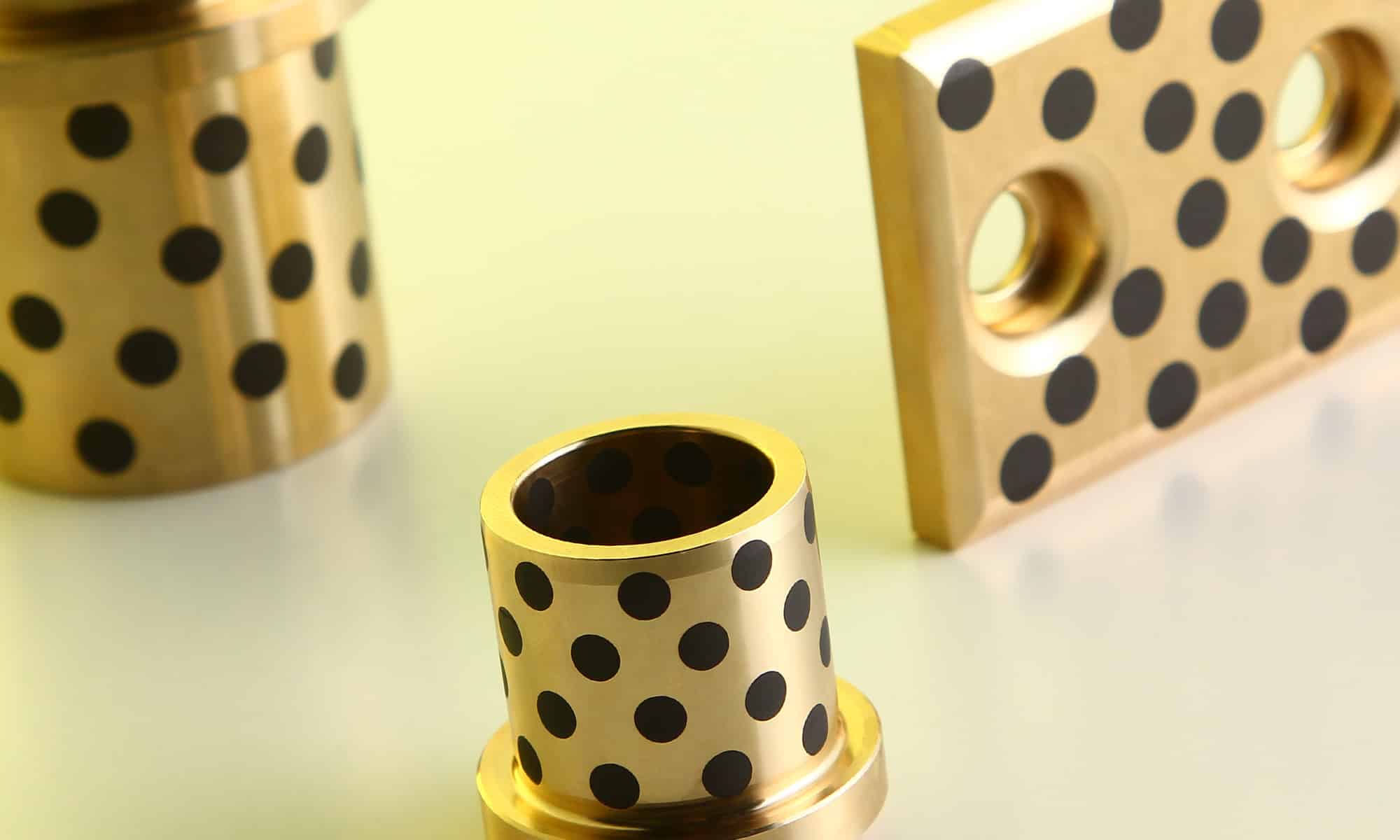
There are several types of slide plates available, each with its own unique features and benefits. The most common types of slide plates include:
- Graphite Slide Plates: Graphite slide plates are made from a high-strength material that offers excellent thermal conductivity and low friction. They are commonly used in applications where high levels of heat transfer are required, such as in heat exchangers and power plants.
Applications of Slide Plates
Slide plates are used in a wide variety of applications, from machinery and equipment to buildings and bridges. Some of the most common applications of slide plates include:
- Machinery and Equipment: Slide plates are used in machinery and equipment to reduce friction between moving parts, prolonging their lifespan and reducing maintenance requirements.
- Buildings and Bridges: Slide plates are often used in buildings and bridges to accommodate movement caused by changes in temperature, seismic activity, or other external factors.
- Construction and Mining Equipment: Slide plates are used in heavy-duty equipment, such as bulldozers and excavators, to reduce friction and wear on moving parts.
Benefits of Slide Plates
Slide plates offer several benefits over other types of sliding mechanisms, such as rollers or bearings. Some of the key benefits of slide plates include:
- Reduced Friction: Slide plates offer a low coefficient of friction, reducing the amount of resistance between two surfaces and allowing for smoother movement.
- Low Maintenance: Slide plates require minimal maintenance, reducing the overall cost of ownership and prolonging the lifespan of machinery and equipment.
- Increased Durability: Slide plates are made from materials that offer high durability and wear resistance, reducing the likelihood of failure and reducing the need for replacement.
Installation and Maintenance of Slide Plates
Installing slide plates is a relatively simple process, but it is important to follow the manufacturer’s instructions carefully to ensure proper installation and operation. Maintenance requirements for slide plates are minimal, but regular inspections should be performed to ensure that they are operating correctly and to identify any signs of wear or damage.
In conclusion, slide plates are a versatile and durable sliding mechanism that offer several benefits over other types of sliding mechanisms. By choosing the right type of slide plate for your application and following proper installation and maintenance procedures, you can ensure optimal performance and longevity.
Slide Plates Material: Exploring Different Bronze Alloys and Graphite-Plugged Plates
Introduction
Bronze alloys have been utilized in various engineering applications for centuries due to their unique characteristics, such as good thermal conductivity, corrosion resistance, and mechanical properties. Slide plates, which are used in numerous industries for motion control and load-bearing applications, are no exception. When it comes to slide plates, material selection is crucial for ensuring optimal performance and longevity. One increasingly popular choice is graphite-plugged bronze alloys. In this article, we will explore different bronze alloy compositions and their properties, as well as discuss the benefits of graphite-plugged slide plates.
Bronze Alloys: An Overview
Bronze is a versatile and durable alloy primarily composed of copper and tin, but other elements such as aluminum, silicon, and phosphorous can also be added to create alloys with specific properties. Some of the most common bronze alloys used in slide plate applications include:
- Tin Bronze (C90700): This alloy contains 88-90% copper and 10-12% tin. It offers excellent wear resistance, making it suitable for heavy-duty applications.
- Aluminum Bronze (C95400): With a composition of 83% copper, 10-11.5% aluminum, and 4-6% iron, this alloy is known for its high strength, corrosion resistance, and good wear resistance.
- Silicon Bronze (C87600): This alloy comprises 94-96% copper, 3-4% silicon, and 1-1.5% zinc. It boasts excellent corrosion resistance, making it suitable for applications in harsh environments.
- Phosphor Bronze (C51000): Composed of 94-96% copper and 4-6% tin with 0.15% phosphorous, this alloy is highly resistant to wear and fatigue.
Graphite-Plugged Bronze Slide Plates
Graphite-plugged bronze slide plates are made by combining the benefits of bronze alloys with the self-lubricating properties of graphite. Tiny graphite plugs are uniformly distributed throughout the bronze alloy surface, creating a low-friction surface that reduces wear and eliminates the need for external lubrication.
Advantages of Graphite-Plugged Bronze Slide Plates
- Self-lubrication: The graphite plugs act as a built-in lubrication system, ensuring smooth operation even under heavy loads and eliminating the need for additional lubricants.
- Extended service life: The self-lubricating properties of graphite-plugged bronze slide plates reduce friction and wear, recognized to a longer service life compared to other materials.
- Corrosion resistance: Bronze alloys are naturally resistant to corrosion, making them ideal for applications in harsh environments or where exposure to moisture is a concern.
- High load-bearing capacity: Bronze alloys offer excellent mechanical properties, making them suitable for heavy-duty applications with high loads.
- Low maintenance: The self-lubricating properties of graphite-plugged bronze slide plates reduce maintenance requirements, as they do not require frequent lubrication or replacement.
Selecting the right material for slide plates is essential for ensuring optimal performance, longevity, and reliability. Bronze alloys, with their excellent mechanical properties and corrosion resistance, have long been a popular choice for slide plate applications. The incorporation of graphite plugs further enhances the benefits of bronze alloys by providing self-lubrication, reduced maintenance, and extended service life. As a result, graphite-plugged bronze slide plates are increasingly being adopted in various industries for their superior performance and cost-effective advantages.
Slide wear bronze graphite plate for pipeline
Self-lubricating Bronze graphite plates offer a unique combination of properties that make them an excellent choice for sliding and wear applications in the pipeline industry.
Bronze graphite plates are a type of composite material that is commonly used in sliding and wear applications in the pipeline industry. These plates are typically composed of a bronze base material that is reinforced with graphite particles. This combination of materials provides several benefits, including high strength, low friction, and excellent wear resistance.
In pipeline applications, bronze graphite plates are often used as wear plates or sliding surfaces in areas where there is significant friction or abrasion. For example, in pipeline valves, bronze graphite plates can be used as seat rings or bearings to reduce wear and extend the lifespan of the valve.
Bronze graphite plates can also be used in pipeline pumps and compressors, where they can provide a low-friction surface to reduce wear and increase efficiency. In addition, bronze graphite plates can be used as wear strips in pipeline support structures to protect against abrasion and wear.
One of the key benefits of bronze graphite plates is their high resistance to corrosion and erosion. This makes them an ideal choice for pipeline applications where the material may be exposed to harsh environments or aggressive fluids.
Self-lubricating bearing plates made up of high-quality bronze with graphite are a type of composite material commonly used in industrial applications where low-friction and long-wear life are required. These bearing plates consist of a bronze base material that is infused with graphite particles, which act as a solid lubricant.
The high-quality bronze used in these bearing plates provides excellent mechanical properties, including high strength, good corrosion resistance, and excellent thermal conductivity. The addition of graphite particles further enhances the properties of the material, providing excellent self-lubricating properties.
Self-lubricating bearing plates made of bronze with graphite are used in a wide range of industrial applications, including machinery, automotive, and marine industries. They are commonly used in bearings, bushings, and other sliding or rotating components.
One of the key benefits of self-lubricating bearing plates made of bronze with graphite is that they can operate under conditions where lubrication is difficult or impossible. The graphite particles within the material act as a solid lubricant, reducing friction and wear between the surfaces in contact.
Another benefit of self-lubricating bearing plates made of bronze with graphite is their long wear life. The combination of bronze and graphite provides excellent wear resistance, making these bearing plates an ideal choice for applications where long-term durability is required.

Self-lubricating bearing plates made of high-quality bronze with graphite are a versatile material that provides excellent mechanical properties, low friction, and long wear life. They are commonly used in a variety of industrial applications where high-performance, low-maintenance components are required.
Standard Oil-Free Self lubricating slide plate graphite copper plate oil-free high force brass slider copper wear plate SEWT28-100 125 150
Self-lubricating slide plate-Standard Type (Copper Alloy) –Graphite Plugged Bearing by www.bronzelube.com.
Oil-Free Self-lubricating slide plate – Standard, Copper Alloy
Slide graphite plate for the oil and gas, petrochemical, and power industries.
Graphite plates are often used in various industrial applications due to their unique properties such as high thermal conductivity, chemical resistance, and low coefficient of friction. In the oil and gas, petrochemical, and power industries, graphite plates are commonly used as sliding surfaces or wear plates.
When used as a sliding surface, graphite plates are typically used in machinery where there is relative motion between two surfaces. For example, in oil and gas drilling equipment, graphite plates may be used as a sliding surface for bearings, bushings, and other components to reduce friction and wear.
In the petrochemical industry, graphite plates can be used as wear plates in pumps, compressors, and valves where abrasive or corrosive materials are present. The high chemical resistance of graphite makes it an excellent choice for applications where other materials would quickly deteriorate.
Graphite plates are also used in power generation applications, particularly in turbines and generators. They are commonly used as wear plates in areas with high contact stress, such as in the sliding contact between the rotor and stator in a generator.
Graphite plates offer a unique combination of properties that make them an ideal choice for sliding and wear applications in the oil and gas, petrochemical, and power industries.
Maintenance-free [ low-maintenance ] sliding elements
are components for mold making and tooling
but are also used in
the automotive industry (tool guides, car body presses, …)
plastic injection molding machines and injection molds
mechanical engineering
shipbuilding
Welding technology
lifting and conveying technology are mostly made of bronze with embedded graphite deposits are available in the following designs
Sliding guide bushes
sliding strips
Guide strips
Angle strips
sliding plates
Flat sliding bearings
Flat guide rails
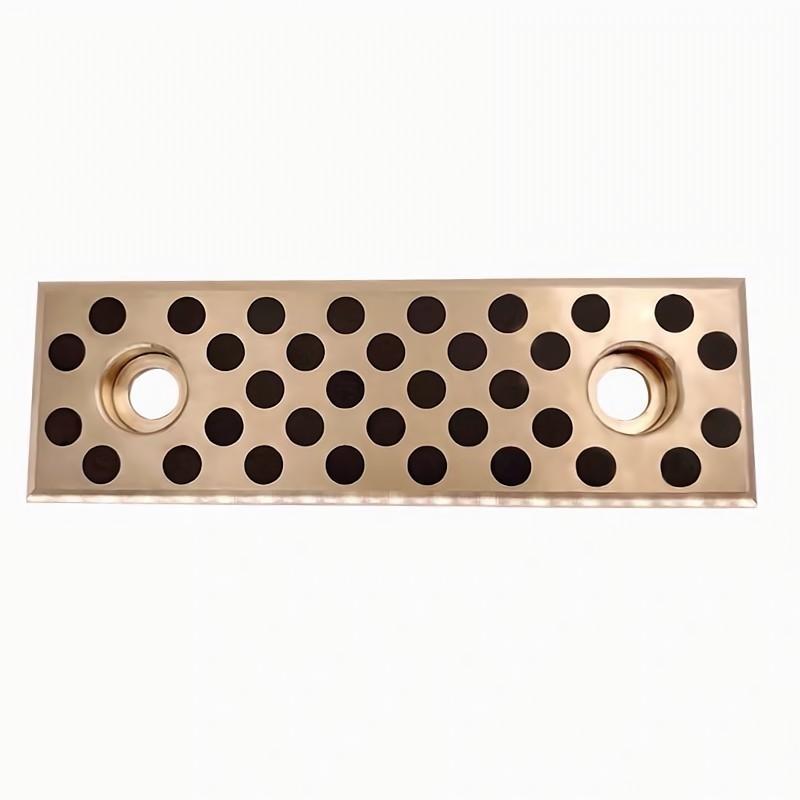
An overview of the available geometries can be found here
Slide plates [ Guide rails ] Angle plates Flat slide bearings have their main application in slide assemblies.
Sliding plates are universally applicable and are also used in machine and plant construction.
There is a wide range of dimensions and designs on the market. If yours is not included, [ no problem ] please ask.
Your application requires special dimensions or [ special designs ] . Also no problem. We also manufacture and sell these components according to customer drawings and in special dimensions.
Maintenance-free does not mean neglecting the [ maintenance ]. The graft depots like it when you regularly receive a little oil. Pleases the depot – keeps it longer – pleases the user – the service life can be influenced with it.
We offer maintenance-free sliding elements as standard slide plates.
Maintenance-free sliding elements
Maintenance-free sliding elements – bushings, sliding plates, flange strips, angle strips, connecting guides, guide pillars, centering units and pin guides – are mainly used in the automotive industry and mechanical engineering.
A self-lubricating slide plate is an innovative component designed to provide smooth and friction-free movement in various applications. It eliminates the need for external lubrication by incorporating self-lubricating properties directly into the material. This type of slide plate offers several advantages, including reduced maintenance, improved performance, and extended service life.
- Self-Lubrication Mechanism: A self-lubricating slide plate incorporates solid lubricants, such as graphite or PTFE (polytetrafluoroethylene), into its composition. These lubricating additives are evenly distributed throughout the material matrix. As the slide plate moves, the lubricants are released, forming a thin film between the sliding surfaces. This self-lubrication mechanism significantly reduces friction and wear, resulting in smoother operation.
- Friction Reduction: The self-lubricating properties of the slide plate minimize friction between the sliding surfaces. The solid lubricants act as a barrier, reducing direct metal-to-metal contact and preventing stick-slip motion. This not only improves the sliding efficiency but also reduces noise and vibration, creating a quieter and more comfortable operating environment.
- Maintenance-Free Operation: One of the key benefits of a self-lubricating slide plate is its maintenance-free operation. Unlike traditional slide plates that require regular lubrication, self-lubricating variants eliminate the need for frequent lubricant application and reapplication. This reduces maintenance costs, minimizes downtime for lubrication tasks, and simplifies overall maintenance requirements.
- High Load-Bearing Capacity: Self-lubricating slide plates are engineered to withstand high loads and pressure. The incorporation of solid lubricants enhances the load-bearing capacity of the material, allowing it to support heavy loads without compromising performance. This makes them suitable for a wide range of applications, including industrial machinery, conveyor systems, and sliding structures.
- Excellent Wear Resistance: The self-lubricating properties of the slide plate contribute to its exceptional wear resistance. The lubricating additives create a protective layer that reduces friction and minimizes wear, ensuring prolonged service life and extended durability. This resistance to wear makes self-lubricating slide plates ideal for applications where frequent sliding and abrasion occur.
- Corrosion Resistance: Many self-lubricating slide plates are manufactured using materials with inherent corrosion resistance, such as bronze or composite materials. This corrosion resistance enables them to withstand harsh environmental conditions, including exposure to moisture, chemicals, and contaminants. The ability to resist corrosion ensures reliable performance and longevity, even in challenging operating environments.
- Versatile Applications: Self-lubricating slide plates find application in a wide range of industries, including manufacturing, transportation, construction, and infrastructure. They are commonly used in sliding bearings, guide rails, conveyor systems, hydraulic cylinders, and other sliding mechanisms. Their versatility and effectiveness make them a preferred choice for engineers and designers seeking reliable, low-maintenance solutions.
Oil-Free Slide Plates – Copper Alloy, 20mm, Volume Discount is available
If you require a custom-sized CuAl10Fe5Ni5 slide bronze plate manufactured according to EN-ISO 9013 cutting tolerances, here’s what you need to know:
- CuAl10Fe5Ni5 Slide Bronze Plate: CuAl10Fe5Ni5 is a specific bronze alloy known for its excellent sliding and wear properties. It offers high strength, good corrosion resistance, and is commonly used in applications requiring low friction and high load-bearing capacity.
- Custom Size Specifications: Prepare a detailed technical drawing specifying the desired dimensions, including length, width, and thickness, for the slide bronze plate. Ensure that your drawing adheres to the EN-ISO 9013 standard for cutting tolerances. This standard defines acceptable deviations during the cutting process to ensure dimensional accuracy.
- Finding a Manufacturer: Search for a reputable manufacturer or machining service that specializes in custom bronze plate fabrication. Look for companies with experience in working with CuAl10Fe5Ni5 or similar bronze alloys and capable of meeting the EN-ISO 9013 cutting tolerances. Consider their expertise, equipment capabilities, and customer reviews to make an informed choice.
- Submitting the Drawing: Contact the chosen manufacturer and provide them with your detailed technical drawing. Clearly communicate your specific requirements, emphasizing the need to adhere to EN-ISO 9013 cutting tolerances. Include all necessary information, such as material specifications, desired quantity, and any additional requirements.
- Material Selection: Specify CuAl10Fe5Ni5 as the desired bronze alloy for the slide plate. Confirm the availability of this particular alloy with the manufacturer. If there are any specific performance requirements or considerations, discuss them to ensure the material selection aligns with your application needs.
- Requesting a Quote: The manufacturer will review your drawing and provide you with a comprehensive quote. The quote should include the cost of manufacturing the custom-sized slide bronze plate, any setup fees, and an estimated timeline for completion. Review the quote carefully, ensuring that it aligns with your specifications and expectations.
- Review and Approval: Thoroughly review the provided quote and ensure that it meets your requirements and budget. Seek clarification or request modifications, if necessary. Once you are satisfied with the quote and all your specifications are accurately reflected, provide your approval to proceed with the manufacturing process.
- Manufacturing and Delivery: Upon receiving your approval, the manufacturer will commence the manufacturing process. Skilled machinists will utilize cutting-edge equipment and techniques to precisely cut the CuAl10Fe5Ni5 slide bronze plate to your custom size specifications, while adhering to the EN-ISO 9013 cutting tolerances.
Once manufactured, the slide bronze plate will be carefully inspected for dimensional accuracy and quality. It will then be appropriately packaged and delivered to your specified location, ensuring its safe arrival.
By following these steps, you can obtain a custom-sized CuAl10Fe5Ni5 slide bronze plate manufactured to EN-ISO 9013 cutting tolerances. Working with a reputable manufacturer ensures the production of a high-quality product that meets your specific requirements for sliding applications.
Product Information slide plate Informational Understanding Slide Plates: Uses, Types, and Benefits Learn all about slide plates, including how they work, what they’re made of, and the different types available. Discover their benefits and uses in various industries. Product Information plugged graphite bronze wear plate Informational The Ins and Outs of Plugged Graphite Bronze Wear Plates Discover what plugged graphite bronze wear plates are and how they work. Learn about their properties, benefits, and applications in different industries. Features and Benefits wear resistance Informational What Makes Plugged Graphite Bronze Wear Plates So Wear-Resistant? Find out what gives plugged graphite bronze wear plates their exceptional wear resistance. Learn about the different factors that affect their performance and how they compare to other wear plate materials. Features and Benefits self-lubrication Informational The Advantages of Self-Lubricating Plugged Graphite Bronze Wear Plates Discover the benefits of using self-lubricating plugged graphite bronze wear plates in your applications. Learn about how they work, their properties, and their advantages over traditional wear plate materials. Applications heavy equipment Informational Using Plugged Graphite Bronze Wear Plates in Heavy Equipment Applications Learn about the various heavy equipment applications where plugged graphite bronze wear plates can be used. Discover their benefits and how they can improve the performance and lifespan of your equipment. Applications industrial machinery Informational The Benefits of Using Plugged Graphite Bronze Wear Plates in Industrial Machinery Discover how plugged graphite bronze wear plates can improve the performance and reliability of industrial machinery. Learn about their applications, advantages, and how they compare to other wear plate materials. Comparison plugged graphite bronze vs other materials Informational Plugged Graphite Bronze Wear Plates vs Other Wear Plate Materials: A Comparison Compare plugged graphite bronze wear plates to other popular wear plate materials, including steel, aluminum, and ceramics. Learn about their strengths and weaknesses, and which material is best suited for different applications. Installation and Maintenance installation tips Informational Tips for Installing Plugged Graphite Bronze Wear Plates Discover best practices for installing plugged graphite bronze wear plates in your applications. Learn about common mistakes to avoid, and how to ensure proper fit and performance. Installation and Maintenance maintenance tips Informational Maintaining Plugged Graphite Bronze Wear Plates: Dos and Don’ts Learn how to properly maintain plugged graphite bronze wear plates to ensure optimal performance and lifespan. Discover common maintenance mistakes to avoid, and best practices for cleaning, lubricating, and replacing your wear plates. Purchase Considerations cost-effectiveness Commercial Are Plugged Graphite Bronze Wear Plates Cost-Effective? Determine whether plugged graphite bronze wear plates are a cost-effective choice for your applications. Learn about their price points, longevity, and how they compare to other wear plate materials in terms of overall value. Purchase Considerations supplier selection Transactional Choosing the Right Supplier for Plugged Graphite Bronze Wear Plates Learn what to consider when selecting a supplier for plugged graphite bronze wear plates. Discover what makes a reliable and trustworthy supplier, and how to ensure you get the best quality products and customer service.
Type: Copper alloy plate
• Thickness (mm): 20
| Self lubricating slide plate | 75*28*20 SEW28-75 |
| Self lubricating slide plate | 100*28*20 SEW28-100 |
| Self lubricating slide plate | 125*28*20 SEW28-125 |
| Self lubricating slide plate | 150*28*20 SEW28-150 |
| Self lubricating slide plate | 200*28*20 SEW28-200 |
| Self lubricating slide plate | 250*28*20 SEW28-250 |
| Self lubricating slide plate | 75*38*20 SEW38-75 |
| Self lubricating slide plate | 100*38*20 SEW38-100 |
| Self lubricating slide plate | 125*38*20 SEW38-125 |
| Self lubricating slide plate | 150*38*20 SEW38-150 |
| Self lubricating slide plate | 200*38*20 SEW38-200 |
| Self lubricating slide plate | 250*38*20 SEW38-250 |
| Self lubricating slide plate | 75*48*20 SEW48-75 |
| Self lubricating slide plate | 100*48*20 SEW48-100 |
| Self lubricating slide plate | 125*48*20 SEW48-125 |
| Self lubricating slide plate | 150*48*20 SEW48-150 |
| Self lubricating slide plate | 200*48*20 SEW48-200 |
| Self lubricating slide plate | 250*48*20 SEW48-250 |
| Self lubricating slide plate | 75*58*20 SEW58-75 |
| Self lubricating slide plate | 100*58*20 SEW58-100 |
| Self lubricating slide plate | 125*58*20 SEW58-125 |
| Self lubricating slide plate | 150*58*20 SEW58-150 |
| Self lubricating slide plate | 200*58*20 SEW58-200 |
| Self lubricating slide plate | 250*58*20 SEW58-250 |
Oil-Free Thin Slide Plates – Copper Alloy
Maintenance-free sliding elements
Self-lubricating slide plate Metric Size made to order:
Self-lubricating slide plate Characteristics:
1. May work without any oil for long period.
2. Extremely high load capacity, good anti-wear, and low friction.
3. Particularly appropriate for low speed and high load.
4. Suitable single-direction axial loads
5. Free design is possible on the shape and size
6. Can be used in a wide range of temperatures, from - 40℃+ 300℃
Oil-Free Plain Guide Rails
• Product Type: Guide rails
• Heel: No groove
• Oil Groove: Oil-free
Your expert in self-lubricating Bearing
and Bronze alloys – serving globally
Brand replacement products and functionally equivalent parts, alternative solutions
Manufactures flange bronze bearings, service & maintenance companies to meet the exacting specifications required in a wide range of industrial applications.
Machined bronze bushing that meet the exacting requirements & specifications supplied by our clients. Spherical bearings, spindles, semi-spheres and supports that we have manufactured.
You will find to follow a selection of self lubricating bronze bearing material CuSn7Zn4Pb7, CuSn12, CuAl10Fe5Ni5,
CuZn25Al5Mn4Fe3
Alternative solution,We offer an outsourced machining service for bronze bushes, manufacturing precise parts to the designs supplied to us by our clients.
Selection of other composite bushing material of self lubricating bearing that we have manufactured.
Wrapped Bronze Sleeve Bearing, Are you interested in our products?
Manufacturer of bimetal and steel bronze bushing parts according to client’s drawing.


